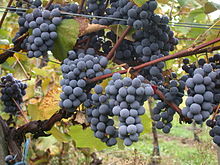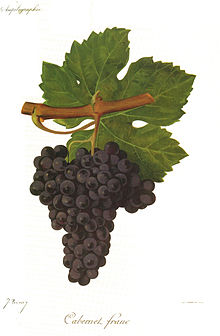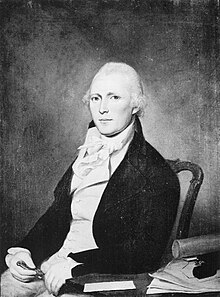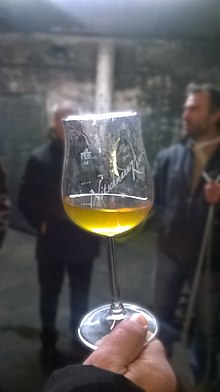
Back Portál:Víno Czech Portal:Wein German Portal:Vino Spanish Portail:Vigne et vin French 포털:포도주 Korean Portal:Vinho Portuguese Purtali:Vinu SCN Portal:葡萄酒 Chinese
The Wine Portal


Wine is an alcoholic beverage made from fermentation of grape juice. The natural chemical balance of grapes is such that they can ferment without the addition of sugars, acids, enzymes, or other nutrients. Although fruits other than grapes can also be fermented, the resultant wines are normally named after the fruit from which they are produced (for example, apple wine) and are known as fruit wine (or country wine). Others, such as barley wine and rice wine (e.g. sake), are made from starch-based materials and resemble beer more than wine; ginger wine is fortified with brandy. In these cases, the use of the term "wine" is a reference to the higher alcohol content, rather than the production process. The commercial use of the word "wine" (and its equivalent in other languages) is protected by law in many jurisdictions. Wine is produced by fermenting crushed grapes using various types of yeast which consume the sugars found in the grapes and convert them into alcohol. Various varieties of grapes and strains of yeasts are used depending on the types of wine produced.
Wine stems from an extended and rich history dating back about 8,000 years and is thought to have originated in present-day Georgia or Iran. Wine is thought to have appeared in Europe about 6,500 years ago in present-day Bulgaria and Greece and was very common in ancient Greece and Rome; the Greek god Dionysos, and his Roman counterpart Liber represented wine. Wine continues to play a role in religious ceremonies, such as Kiddush in Judaism and the Eucharist in Christianity. (Full article...)
Selected articles -
Did you know (auto-generated) -

- ... that the wine cellar of New York City's Barclay Hotel is on the second floor?
- ... that both scholars and activists believe that diet culture is often intertwined with racism and other forms of prejudice?
- ... that illustrator Abigail Larson once designed a wine-bottle label for the Edgar Allan Poe Museum?
- ... that when Fred Franzia created Two-Buck Chuck, he was said to have "turned the wine industry on its head"?
- ... that Julia Marden was the first known person to create a Wampanoag twined turkey-feather mantle since European contact 400 years earlier?
- ... that sociologist Richard Twine has developed the concept of the "vegan killjoy" who challenges anthropocentrism by their mere presence?
- ... that Eminem promoted "Houdini" with a video in which David Blaine eats a wine glass?
- ... that a £142 wine fridge was smuggled into Downing Street on 11 December 2020, during the height of the COVID-19 lockdown in the United Kingdom?
Selected quote
| “ | Wine is bottled poetry. | ” |
| — Robert Louis Stevenson |
Related portals
Selected winery
The Eyrie Vineyards is an American winery in Oregon that consists of 49 acres (20 ha) in several different vineyards in the Willamette Valley. The vineyards and winery were established by owner and winemaker David Lett, who produced the first Pinot gris in the United States. Against the advice of viticultural professors at the University of California, Davis, Lett and his wife, Diana, moved to Oregon to plant Pinot noir in 1965. They founded Eyrie Vineyards in 1966, and their first vintage was 1970.
The 1975 Eyrie Vineyards Reserve Pinot Noir won tenth place among Pinot noirs in blind tasting at the Wine Olympics in 1979. Burgundy winemaker Robert Drouhin organized a re-match at Maison Joseph Drouhin in France. The 1975 Eyrie Vineyards Reserve won second place, losing to Drouhin's 1959 Chambolle-Musigny by only two tenths of a point. Drouhin later purchased land in Oregon and built Domaine Drouhin Oregon.
Over the years, David Lett (known locally as "Papa Pinot") maintained a light-handed style of Pinot noir that did not follow the trend toward greater flavor, tannin, and color extraction, believing color not to be an indicator of quality in Pinot Noir. This put him at odds with some of the wine critics. (Full article...)
General images -
Selected picture
Topics
List articles

Categories
Related WikiProjects
| Parent project: WikiProject Food and Drink | |
| Child projects: | Task forces: (All inactive) |
|
|
| Related projects: | |
Things you can do
|
|
Here are some tasks you can do for WikiProject Wine:
|
Associated Wikimedia
The following Wikimedia Foundation sister projects provide more on this subject:
-
Commons
Free media repository -
Wikibooks
Free textbooks and manuals -
Wikidata
Free knowledge base -
Wikinews
Free-content news -
Wikiquote
Collection of quotations -
Wikisource
Free-content library -
Wikispecies
Directory of species -
Wikiversity
Free learning tools -
Wikivoyage
Free travel guide -
Wiktionary
Dictionary and thesaurus






































































